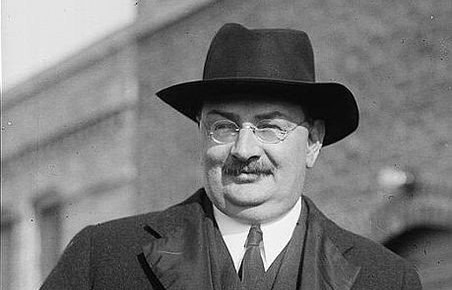Santeri Nuorteva, a Finnish Socialist in the United States
In their Communist Manifesto of 1848, Karl Marx and Friedrich Engels declared that the working class should ‘win the battle of democracy’ by taking the reins of social power. This proletarian revolution would topple the exclusive control over investment and planning by owners of private capital and create a new order in which productive property would be held in common, class antagonism would disappear, and there would arise ‘an association, in which the free development of each is the condition for the free development of all.’ By the turn of the twentieth century, these ideas gained had foothold in the United States, where the radical left similarly anticipated a socialist future. Although it remained electorally marginal, the nascent American socialist movement nonetheless offers important insights into the political history of the United States – especially at a time that self-declared ‘democratic socialism’ is experiencing a resurgence on the left flank of the Democratic Party.
Given the over-representation of European immigrants among American factory workers, it is not surprising that many socialist figures too, had roots outside the United States. Some of the most prominent were Finnish or Jewish emigrants, who had come to socialist politics in the volatile political climate of the Russian empire. This was certainly true for Santeri Nuorteva, a Russian-Finnish migrant who was to play an important – if often understated role – in radical left politics on both sides of the Atlantic. Nuorteva was born Alexander Nyberg in the city of Viipuri in Eastern Finland, the son of a Finnish-Swedish telegraph officer and a Russian-Jewish mother. He was drawn to leftist politics in the wake of Russia’s 1905 revolution, which had also convulsed Finland. Around 1908, he Nuorteva began editing a Finnish newspaper; the revolutionary character of his writings did not go unnoticed, and Czarist authorities soon arrested him.
Nuorteva escaped from prison and fled to the United States in 1912, via Sweden. He went to Astoria, Oregon, where he started working with the growing Finnish-American socialist movement. Reflecting the influence of socialism in Finland itself, Finnish-American immigrants were notably active in left-wing politics: in 1913, the Finnish Socialist Federation counted over twelve thousand members, about ten percent of all Finnish-Americans. Yet for all their efforts, they did not significantly impact the larger radical movement: most Finns lived the mining towns of the northern Great Lakes and argued about politics in a language few other Americans understood. This experience put Nuorteva in touch with other prominent Finnish socialists such as Wilhe Roman, Vihtori Kosonen, Taavi Tainio, and Eetu Salin. They were all marked as radicals, and became the object of military surveillance following the outbreak of the First World War.
It is not clear when Nuorteva came to the attention of the US Military Intelligence Division, but by August 1918, the American government had marked him as a dangerous radical. At least since April 1917, his actions had invited scrutiny: he raised funds for a Finnish revolution and called on fellow Finnish-Americans to oppose the draft. Following the October Revolution of 1917, events in Europe placed such activity in a particularly troubling light. When the Bolsheviks announced a general right of self-determination “for the Peoples of Russia,” the Finnish parliament proclaimed independence. During the ensuing civil war between the Finnish Worker’s Republic and the German-backed reactionary forces, Nuorteva came to prominence as the primary spokesman for ‘Red Finland’ in the United States. Even more worrying – from the perspective of the American authorities – was his alignment with the Soviet Union: Nuorteva served as secretary to Ludvig Martens, Lenin’s unrecognized representative to the United States, and led a Diplomatic and Publicity Department that was reportedly “entrusted with the task of presenting the American people the true facts about conditions in Russia.” His paper, the Rayvaaja, was the primary Finnish-language socialist organ in the US, and he was also a member of the National Executive Committee of the Socialist Party of America.
In 1919, with the anti-communist ‘Red Scare’ in full swing, Nuorteva was called before a US Senate committee investigating Bolshevik propaganda. In June of 1920, facing arrest, he relocated to Canada with false papers, and briefly continued his work there. Similarly hounded by the Canadian authorities, he fled to England, where he was promptly arrested for domestic subversion and deported to Soviet Russia. Back in Russia, Nuorteva became head of the America section of the Russian Foreign Office until he was suddenly accused of being a anti-Soviet agent suspected of taking part in a ‘gigantic plot within the Bolshevist ranks to undermine and upset the newly born regime. The latter accusation may refer to a curious episode involving one Washington B. Vanderlip, a relative of the wealthy Frank A. Vanderlip, a New York Banker. In the Fall of 1920, Vanderlip presented himself to the Bolshevik authorities as a potential investor in the Soviet Union – he floated a somewhat fantastical scheme to a lease a vast stretch of Siberian territory with with exclusive rights to exploit the coal, oil, and fisheries of the region. Seeking to oppose the deal, Nuorteva spoke out openly against it, causing a momentary rift with Lenin that led to his investigation and imprisonment by the Cheka. In the end, Nuorteva was acquitted of his alleged treason. His criticism on Lenin’s deal with Vanderlip exemplified the periodic intensity of infra-socialist quarrels, as well as the confused state of American-Soviet relations in the early years following the October Revolution.
This piece was written using the following microfilm reports:
U.S. Military Intelligence Reports; surveillance of radicals in the United States 1917-1941, Reel 9, p.542-562.
(microfilm edition, Roosevelt Institute for American Studies, Middelburg).



